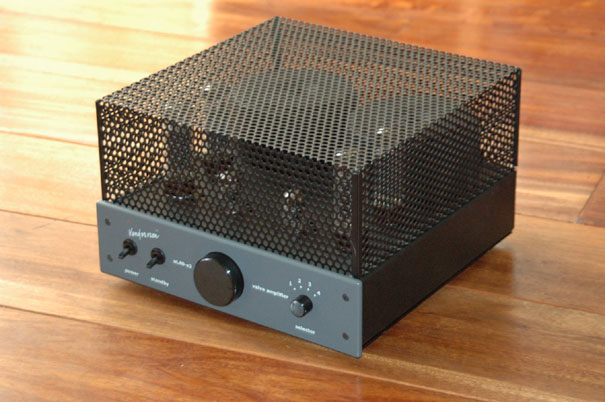
It is already several years ago that I designed the UL40-S2 tube-amplifier. In those days tubes were easy to get. I used NOS-EL34’s from Philips and later from Svetlana (with gold-control-grid). Abundant tubes were available, because of their application in quality guitar amplifiers.
Now the situation has changed a little bit. Svetlana ceased production. I also received many requests from customers to apply other tubes like 6550 or KT88. In the last years we saw the birth of new tubes from Tung-Sol, like the KT120 en very recently the KT150. I tried all these tubes in the UL40-S2, and they performed fine. Only the KT88 sometimes showed a little tendency to oscillation, which I have described and solved. See an earlier report on my website.
To inform you all about the present situation, I performed a new test with 14 types/brands. I plugged these tubes into the original UL40-S2. I measured the quiescent current I0, the anode plus grid-2 dissipation Pa+g2 and the distortion of a 1 kHz sine at a level of 1 Watt into a 4 Ohm load. I also calculated the class-A power range (both tubes are working). To my satisfaction all tubes operated in this class-A almost to the maximum output power Pout,max = 25 W. All tubes settled themselves to a working point below their maximum dissipation Pa,max. The tube with the lowest THD gets the highest ranking. See the results of my test in the following list.
|
VALVE |
I0 |
Vak |
Pa+g2 |
Pa,max |
THD @ 1kHz |
Ranking |
Remark |
|
units |
mA |
V |
W |
W |
% |
1 to 10 |
Pout,max ,UL40S2 = 25 W |
|
EL34 Tung-Sol |
59 |
337 |
20 |
25 |
0,13 |
2 |
Pout to 20 W in class A |
|
EL34S Shuguang |
53 |
343 |
18 |
25 |
0,19 |
1 |
Pout to 18 W in class A |
|
LL34 L’Atout |
60 |
336 |
20 |
25 |
0,1 |
4 |
Pout to 20 W in class A |
|
6550 Tung-Sol |
79 |
321 |
25 |
42 |
0,13 |
2 |
Pout to 25 W in class A |
|
6550 SED |
75 |
325 |
24 |
40 |
0,09 |
5 |
Pout to 24 W in class A |
|
6550C Svetlana |
77 |
318 |
24 |
40 |
0,11 |
3 |
Pout to 24 W in class A |
|
6550WE Sovtek |
81 |
321 |
26 |
40 |
0,13 |
2 |
Pout to 25 W in class A |
|
KT66 Gold-Lion Genalex |
71 |
328 |
23 |
32 |
0,073 |
7 |
Pout to 23 W in class A |
|
KT77 Gold-Lion Genalex |
60 |
336 |
20 |
28 |
0,032 |
10 |
Pout to 20 W in class A |
|
KT88 Gold-Lion Genalex |
73 |
326 |
24 |
40 |
0,11 |
3 |
Pout to 24 W in class A |
|
KT88 JJ-Electronic |
76 |
325 |
25 |
40 |
0,11 |
3 |
Pout to 25 W in class A |
|
KT90EH Elektro Harmonix |
71 |
329 |
23 |
50 |
0,045 |
9 |
Pout to 23 W in class A |
|
KT120 Tung-Sol |
78 |
324 |
25 |
60 |
0,055 |
8 |
Pout to 25 W in class A |
|
KT150 Tung-Sol |
82 |
319 |
26 |
70 |
0,08 |
6 |
Pout to 25 W in class A |
The absolute winner is the KT77. This tube looks like the EL34 and LL34 tubes. They all show a quiescent current of about 60 mA, well within the original design range. No changes in the UL40-S2 design are needed for, it all is totally correct. I find the low distortion of the KT77 remarkable and very noticeable. See in this regard also my SE-amplifier research where I indicate the importance of low 2-nd harmonic distortion for the clear perception of space and details: TS2016-report-Menno.pdf. I there also explain why it is important to measure harmonic distortions at 1 Watt output level.
All other tubes have higher quiescent currents ranging from 70 mA to 82 mA. For these tubes I advise a small change in the schematics of the UL40-S2. The cathode resistor R17 = 220 Ohm is standard a 5 W type. It is better to change it into a 7 Watt type. The cathode decoupling capacitor C6 is standard 1000uF/40V . As result of the larger quiescent currents the 40V voltage headroom becomes rather small. I advise to change C6 into a 1000uF/63V type to create abundant headroom. Ask Amplimo (www.ringkerntrafo.nl) for the availability of R17 and C6 and most of the tubes in my test-list.
A last remark: when you apply the Vanderveen-Tentlabs auto-bias unit in the UL40-S2, you can set the quiescent current at any value you like. For all the tubes 60 mA is a good choice, to extend the life-span of the tubes and to get a wide class-A range. No changes in R17 and C6 are needed for, because these components are removed when you apply the auto-bias unit.
With many thanks to Jack van Brederode (TubeSociety student) who informed my about the good qualities of the KT77.
29-6-2017 Menno van der Veen
